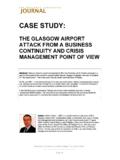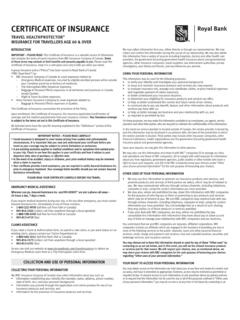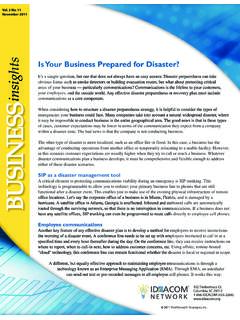Transcription of How to Deploy BSI 25999 to - Continuity Central
1 Authored By Avalution Consulting and BSI Management Systems America How to Deploy BS 25999 second edition 2 How to Deploy BS 25999 (second edition) T AB LE OF C ON T EN T S TABLE OF CONTENTS .. 2 1. INTRODUCTION .. 3 2. ACHIEVING PROGRAM CREDIBILITY BY CHOOSING THE RIGHT STANDARD FOR YOUR ORGANIZATION .. 4 How to Choose the Best Standard for Your Organization .. 4 How BS 25999 Answers These Questions .. 4 3. USING THE STANDARD TO BUILD YOUR PROGRAM .. 5 An overview of BS 25999 .. 5 Planning the BCMS .. 7 Program Requirements .. 7 BCM 7 Provisioning Resources and Competency of Personnel .. 7 Embedding BCM .. 8 Documentation and Records .. 8 Implementing and Operating the BCMS .. 9 Understanding the Organization .. 9 BIA and Risk Assessment .. 9 business Continuity Strategy .. 11 Planning Activities .. 13 Exercising and Maintaining BCM Arrangements .. 15 Monitoring and Reviewing the BCMS .. 16 Internal Audit.
2 16 Management Review .. 16 Maintaining and Improving the BCMS .. 17 Preventive and Corrective Actions .. 17 Continual Improvement .. 17 4. KEY PROGRAM IMPROVEMENT OPPORTUNITIES .. 18 5. TAKING THE NEXT STEP: THE CERTIFICATION PROCESS .. 19 6. CONCLUSIONS .. 22 ABOUT AVALUTION CONSULTING .. 23 ABOUT BSI MANAGEMENT 23 This second edition of How to Deploy BS 25999 addresses changes to the BS 25999 -2 Specification, finalized in late 2007, after the initial release of the white paper. This edition also takes advantage of lessons learned from recent BCMS development projects designed to meet BS 25999 requirements. 2008 Avalution Consulting, LLC & BSI Management Systems America, Inc. | All Rights Reserved 3 How to Deploy BS 25999 (second edition) The purpose of BS 25999 is to provide a basis for understanding, developing and implementing business Continuity within an 1. I N T RODUC TI ON business Continuity programs, similar to other enterprise risk management processes, are most effective when grounded in generally-accepted standards and built according to the business objectives.
3 business objectives and proven standards together form a foundation that adds both credibility and viability to a Continuity program. This white paper explores a new international code of practice (and its associated specification document), the British Standard Institution s British Standard (BS) 25999 , viewed by a growing body of practitioners as a complete description of a mature, repeatable and actionable business Continuity management program. In addition to providing implementation details for the standard, this document covers how to use BS 25999 to obtain executive support, create a business Continuity program and/or increase the maturity of an existing program. BS 25999 provides a basis for understanding, developing and implementing business Continuity within an organization, integrates risk management disciplines and processes with business Continuity and provides confidence in business -to- business and business -to-customer dealings.
4 BS 25999 is written in two parts. Part 1, the Code of Practice, outlines the standard s overall objectives, guidance and recommendations. Part 2, the Specification, details the activities that should be completed in order to meet business Continuity objectives within the context of an organization s risk management philosophy. Part 2 is designed to be auditable , meaning only objective, measurable requirements are included in the Specification. Background: From business Continuity Planning to a business Continuity Management System business Continuity is a rapidly maturing discipline that has moved from the realm of IT systems recovery to holistic business recovery and resiliency. With these changes, business Continuity -related terminology also matured. A few years ago, business Continuity planning (BCP) was the latest term to articulate the growing role Continuity played in protecting critical business processes from failure. As this practice grew and established itself as a key risk management discipline, a movement toward standardization occurred, similar to the quality initiative standardization experienced in the 1990 s.
5 As a result, systems thinking (such as quality systems) has been applied to business Continuity , resulting in a new term: business Continuity Management System (BCMS). While BCMS sounds like some new class of pricy business Continuity software, it s not. BCMS refers to a program that encompasses the development and management of policies and procedures to protect an organization s people, processes and supporting technology. BS 25999 proposes and evaluates business Continuity based on this collection of processes and resources referred to as holistic systems thinking. Support Grows for BS 25999 Internationally Prior to formal publication, most draft British Standards draw an average of 250 downloads. BS 25999 -1 (the Code of Practice), however, logged some 5,000 downloads, twenty times more than normal. This extraordinary number of downloads demonstrates how important this issue is to a large number of organizations. Additionally, since the release of BS 25999 -2 (the Specification) in November 2007, over 4,000 copies have been purchased.
6 Another important consideration is that two of the largest American insurance brokerages, Aon Corporation and Marsh Inc., participated on the drafting committee. This interest and participation is very unique and is an early indication that the standard and certification will have strong support from the insurance industry. It is a benefit to insurance providers if they can persuade their customers to develop and maintain a strong, viable BCMS; business interruption-related risk decreases, thereby decreasing claim payments. As you read this white paper, it will be helpful to refer to both parts of BS 25999 . You can purchase your own copy of BS 25999 parts 1 and 2 from the BSI Global website ( ). 4 How to Deploy BS 25999 (second edition) 2. A C HI E V I N G P R O G R A M C RE D I B I L I T Y B Y C HO O S I N G T H E R I G HT S T A N D A R D F O R Y O U R O R G A N I Z A T I O N 2 . 1 . HO W T O C HO O S E T H E B ES T S T A N D A R D F O R Y O U R O R G A N I Z A T I O N Directors of business Continuity often cite standards as evidence that they are performing (or need to perform) key activities.
7 However, the most important aspect of effectively using a standard as a benchmark is choosing the right standard. The following questions can help an organization evaluate the various standards to find the best fit: 1. Is the standard international in nature, providing a framework agreeable to organizations and bodies regardless of geography? 2. Does the standard provide a concise and complete framework, outlining not only business Continuity but also risk analysis and mitigation activities? 3. Does the standard reflect management s approach regarding risk management? 4. Is the standard grounded in business terminology, not business Continuity terms? 5. Does the standard instill management confidence by describing key components of an internationally-accepted business Continuity management system, as well as how to achieve key risk management objectives? 6. Does the standard focus on program development, long-term program management and continuous improvement?
8 2 . 2 . HO W BS 2 5 9 9 9 A N S W ERS T H E S E Q U E S T I O N S BS 25999 provides an organization with guidance and details necessary to build and improve its BCMS. Read the following statements to determine if BS 25999 is the right choice for your organization. 1. BS 25999 is an internationally-accepted standard, developed by the world's leading international standards, testing, registration and certification organization. 2. A standard is often needed to help focus a program on key activities designed to increase responsiveness, resiliency and recoverability. BS 25999 provides a straightforward framework and specification to follow and focuses attention on the most critical business activities. When developing a business Continuity program, it is essential to know the differences between a business Continuity management system and a business Continuity plan. business Continuity plans, by definition, are documents focusing solely on the recovery from an interruption, leaving the residual risks of an interruption occurring unmitigated.
9 BS 25999 outlines a system to address and reduce the risk of an interruption occurring, as well as respond to the risks that occur following an interruption. 3. An organization should select a standard that reflects the entity s current approach to risk management. The standard should be geared to achieve risk management by assessing critical activities and objectives. If these objectives do not align with the organization s approach, attempts to modify the standard will weaken the system structure. Similarly, if efforts are made to modify the organization s approach to risk management to match the standard, the organization may resist changing its culture. 4. Although the use of terminology is inevitable, extensive use of acronyms and dated terminology should be avoided; instead, any terms used should be descriptive and require very little explanation. Reference section 3 of the Specification to further understand the basic terminology used by BS 25999 .
10 5 How to Deploy BS 25999 (second edition) 5. Standards can be confusing, as many are generalized and provide only high-level explanations regarding outcomes. BS 25999 was developed in two parts, the Code of Practice and the Specification, to make the standard easier to understand and implement. Part 2, the Specification, sets out minimum objective requirements for an effective BCMS and provides a framework for its implementation, management and continuous improvement. It is written in such a way to enable compliance measurement. Part 1 of the standard outlines a good practice , moves beyond the minimum requirements and discusses risk management opportunities and methods of meeting business objectives. 6. BS 25999 outlines a BCMS continuous lifecycle approach to improvement, defining the system as a living and continuously evolving program. Figure 1 depicts this lifecycle. 3. USI N G T HE ST AN DARD T O BUI LD YOUR PROG RAM BS 25999 describes big picture process expectations (the Code of Practice), as well as details on how to meet the expectations (the Specification).












